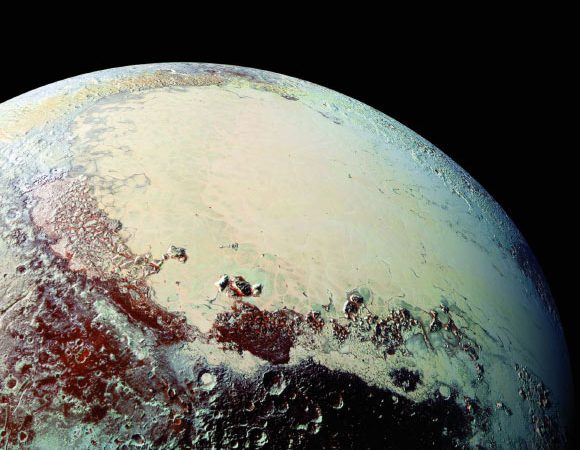Collisions between bodies in our Solar System produce impact craters on large objects at a rate that depends on the population of impacting small bodies. By mapping the scars of ancient impacts on the surfaces of Pluto and its moon Charon, planetary researchers have discovered a surprising lack of very small objects (from 300 feet to 1 mile, or 91 m to 1.6 km, in diameter) in the Kuiper Belt.
Source: Sci News
The Kuiper Belt is a vast halo of orbiting debris lying at the fringes of the Solar System.
While its is home to several large objects — dwarf planets like Pluto — little is known about the distribution of Kuiper Belt objects (KBOs) smaller than 62 miles (100 km) in size, which are remnants from the formation of the Solar System.
Telescopic observations of small KBOs from Earth is difficult with only the largest objects identified.
However, for billions of years, Pluto and Charon have collected craters formed by collisions with smaller KBOs.
“These smaller Kuiper Belt objects are much too small to really see with any telescopes at such a great distance,” said Dr. Kelsi Singer, a researcher at the Southwest Research Institute and a co-investigator of NASA’s New Horizons mission.
“New Horizons flying directly through the Kuiper Belt and collecting data there was key to learning about both large and small KBOs.”

Singer et al studied the craters and geology on Pluto and Charon and found there were fewer small craters than expected; imaged by New Horizon’s LORRI camera, the smooth, geologically stable ‘Vulcan Planitia’ on Charon illustrates these findings. Image credit: NASA / Johns Hopkins University Applied Physics Laboratory / LORRI / Southwest Research Institute.
Using detailed images collected by New Horizons, Dr. Singer and colleagues mapped the craters on Pluto and Charon to determine the sizes of the impacting KBOs.
Accounting for recent geological processes, which can erase older impact craters, they identified some surfaces on the dwarf planet and its satellite which are at least 4 billion years old.
The researchers also report a lack of craters smaller than 8 miles (13 km) in diameter.
“A major part of the mission of New Horizons is to better understand the Kuiper Belt,” Dr. Singer said.
“With the successful flyby of Ultima Thule early this year, we now have three distinct planetary surfaces to study. We use the data from the Pluto-Charon flyby, which indicate fewer small impact craters than expected. And preliminary results from Ultima Thule support this finding.”
Typical planetary models show that 4.6 billion years ago, the Solar System formed from the gravitational collapse of a giant molecular cloud.
The Sun, the planets and other objects formed as materials within the collapsing cloud clumped together in a process known as accretion.
Different models result in different populations and locations of objects in the Solar System.
“This surprising lack of small KBOs changes our view of the Kuiper Belt and shows that either its formation or evolution, or both, were somewhat different than those of the asteroid belt between Mars and Jupiter,” Dr. Singer said.
“Perhaps the asteroid belt has more small bodies than the Kuiper Belt because its population experiences more collisions that break up larger objects into smaller ones.”
The study was published in the journal Science.

































Leave a Comment
You must be logged in to post a comment.